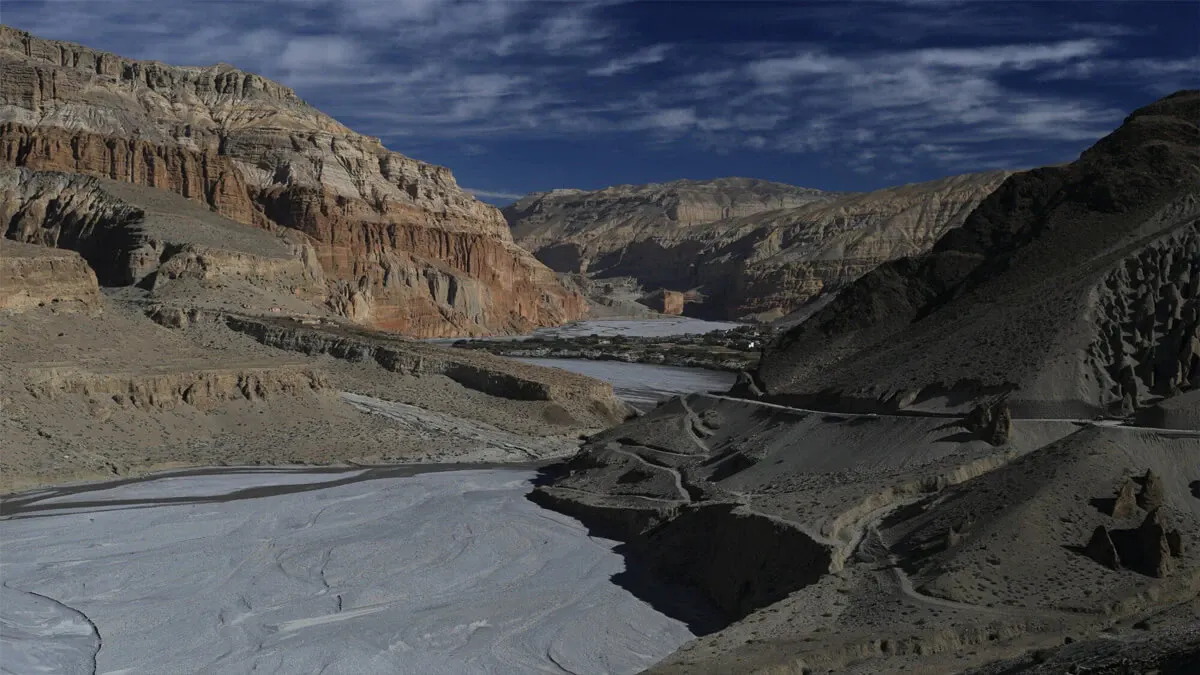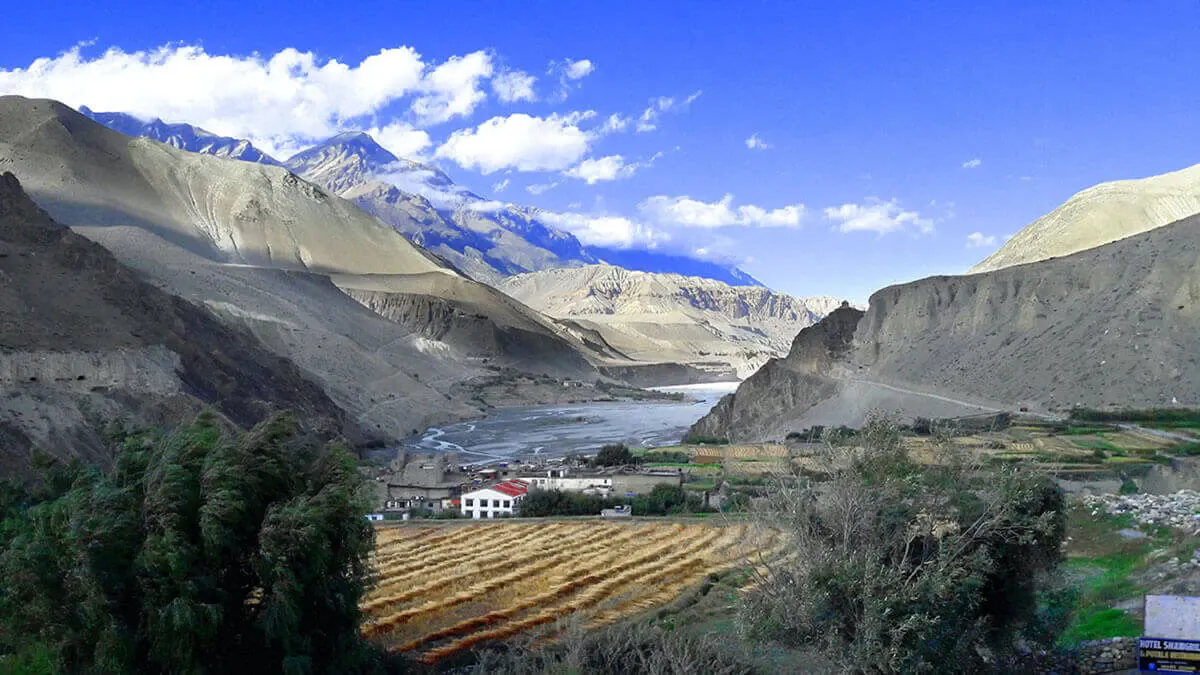- Day 01: Kathmandu to Pokhara
- Day 02: Pokhara to kagbeni via Jomsom flight
- Day 03: Kagbeni to Chele
- Day 04: Chele to Syangboche
- Day 05: Syangeboche to Gheling
- Day 06: Trekking from Gheling to Ghami
- Day 07: Trekking from Ghami to Charang
- Day 08: Trekking from Charang to Lo-Manthag
- Day 09: Lo-Manthang rest
- Day 10: Lo-Manthang to Ghami via upper route
- Day 11: Ghami to Chele
- Day 12: Chele to Jomsom
- Day 13: Jomsom to Pokhara flight
- Day 14: Pokhara to Kathmandu
Day 01: Kathmandu to Pokhara
You have to take a half an hour local flight from Kathmandu, the capital city of Nepal to reach to Pokhara. This is a short flight and presents you with scenic beauties. Alternatively, you may opt for a 6hours drive to Pokhara and stay overnight in Pokhara.
Day 02: Pokhara to kagbeni via Jomsom flight
You will drive to the airport of Pokhara for catching another short flight of 15 minutes to reach at Jomsom i.e. headquarter of the district Mustang and a region of Thakali people. At this point, you will start your trek across Kali Gandaki valley for reaching to Kagbeni.
Day 03: Kagbeni to Chele
Today, our team will take you for a walk across the riverbed of Kali Gandaki to come across Chhusand and Tangbe veillages. The entire area consists of barren landscapes to remind you of the Tibetan plateau. Later on, you have to cross a suspension bridge for reaching the Chele village and stay overnight there.
Day 04: Chele to Syangboche
We will cross two passes named Dorje La Pass at 3735meters and Taklam La Pass at 3624meters via Ghiling Vhena to reach at Syangboche from Chele.
Day 05: Syangeboche to Gheling
We continue with our trek across barren and rugged landscapes to cross Yamda La and Nyi La mountain passes at 3850meters and 4010meters respectively to get spectacular views of Mount Dhaulagiri and Mount Annapurna, while stay overnight in Gheling.
Day 06: Trekking from Gheling to Ghami
Today, you will get stunning views of landscapes, cliffs and nearby villages to reach at Ghami
Day 07: Trekking from Ghami to Charang
We will cross Charang La Pass at 3870meters to reach at Charang Village and have an overnight stay there. Specialty of Charang village is that it has mani walls and almost similar type of culture followed by Tibet people.
Day 08: Trekking from Charang to Lo-Manthag
Finally, today will reach at Lo-Manthang, known as the forbidden kingdom consists of many white washed walls and renowed palaces. Here, you will view old monasteries and get glimpse of Tibetan Buddhism.
Day 09: Lo-Manthang rest
You require taking rest and have relaxed in the Lo Manthang region to acclimatize yourself with the high altitude and weather. You may make a visit across the entire walled city and view a large number of beautiful monasteries.
Day 10: Lo-Manthang to Ghami via upper route
Our team will take back to Ghami by following the same route that you followed before.
Day 11: Ghami to Chele
Our downhill trek will continue to reach to Chele and stay overnight there.
Day 12: Chele to Jomsom
On the last day of your trek, you will go back to Jomdom across the Kali Gandaki River Bank. You may explore the entire area in Jomsom and enjoy views of Dhaulagiri and Annapurna mountain peaks.
Day 13: Jomsom to Pokhara flight
We will drive back to Jomsom and take a local flight to reach Pokhara and stay overnight in Pokhara.
Day 14: Pokhara to Kathmandu

1. What permits do I need to do Upper Mustang trek?
To do Upper Mustang Trek, you must have the following permits
TIMS card,
ACAP Permit and
Upper Mustang Restricted Area Trekking Permit. To collect these
2. What is the cost of the Upper Mustang trek permits?
The cost of Upper Mustang Trek permit is USD 500 for first 10 days and then USD 50 per extra day. This permit is issued by Immigration Office, Kathmandu. TIMS card needs USD 10 and it is managed by the trekking agency. And Annapurna Conservation Area Project Permit costs USD 27 and you get it from the office of ACAP.
3. Can I do Upper Mustang trek alone?
No, you can’t. Upper Mustang trek is a restricted area trekking in Nepal, so one can’t do this trek alone. For this trek, there must be two members in a group accompanied by a registered trekking guide and a porter. The trekking guide takes you along the right trail and helps in case of any emergency.
4. Can I get altitude sickness during this trek?
When you are travelling through the landscapes above 2,500m, there is always chance for altitude sickness. Lo Manthang (3,840m), the Capital of the ancient Himalayan Kingdom is the highest place to spend the night. Although there are three high passes above 3,800m, you spend the limited time over there. However, you can avoid the altitude sickness or AMS (Acute Mountain Sickness) if you follow some precautions. You must walk slowly by taking enough rest. You should have enough drinking water and hygienic food including sound sleep. For safety measure, you should pack some medicines like Acetazolamide and Diamox Oral in your backpack. As soon as you feel any symptom of such problem, you should share it with the guide. He can help you get rid of this as he is habituated to walking in the high altitude palce.
5. Why Upper mustang trek is Expensive then other trek?
Upper Mustang Trek is more expensive than other treks because it requires a special permit from the gov
Cost Inclusion
- Airport pick-up and drop off service ,
- Trekking Guide
- Breakfast, Lunch, Dinner & accommodation during the trekking
- Sleeping bags, down jackets, duffel bags and trekking sticks if required,
- Trekking permit of National park & Restricted area permit
- TIMS(Trekking Information Management System )
- Insurance and equipment for the trekking staffs
- First aid kit
- Farewell dinner in Kathmandu with cultural program in typical Traditional Nepali resturant
Cost Exclusion
- Personal expenses
- Drinks, beverages, hot shower,
- Travel insurance
- Tips for Guide and porter (trekking staff)
- Meals & hotel accommodation in Kathmandu (with out iteniry)


